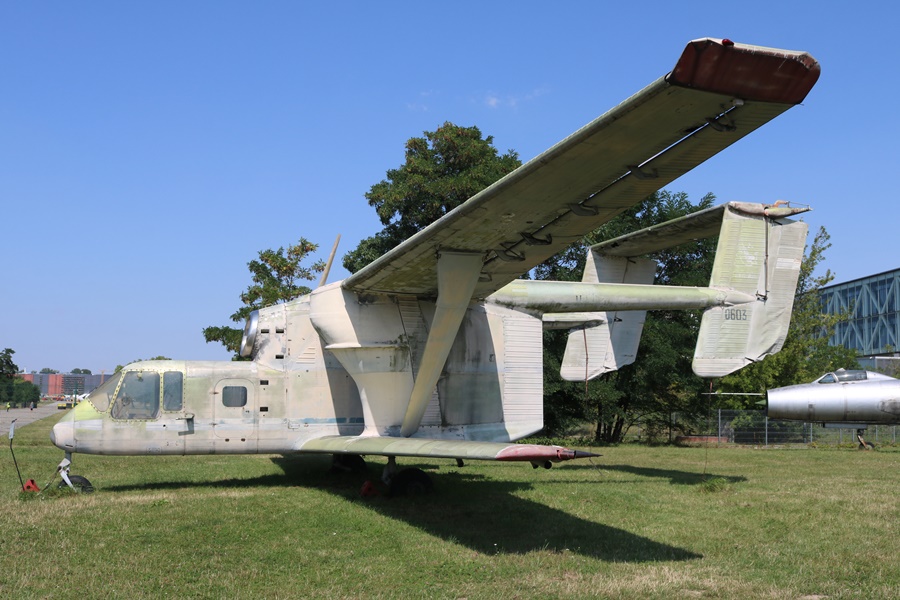On the far side of the outdoor air park at the Polish Aviation Museum in Krakow you will find a very unusual oddity in aviation history. There you will see a bizarre looking jet powered twin boom biplane that could well have been inspired by Frank Herbert’s tales of Dune!
What is it? This large and ungainly looking aircraft is a PZL M-15 Belphegor Ag-plane, designed and built in Poland in the 1970’s. Designed for utilitarian, practical purpose rather than beauty!

In the early 1970’s the Soviet Union were looking into jet powered agricultural aircraft for crop spraying and crop dusting. The Polish aviation industry were invited to be involved in this project. The intention was to be able to cover large agricultural areas more quickly and efficiently than traditional Ag-planes such as the Antonov An-2R Colt (also licence built by WSK-PZL Mielec).


The WSK-PZL Mielec design team started work on the M-15 in 1971. The biplane aircraft had a wingspan of 22 metres (73 ft), featured a fixed tricycle undercarriage (needed due to the low-level flying and rapid turn around required for this type of work) and was powered by a Ivchenko AI-25 turbojet engine that produced 3,000lb of thrust (also used in the Yakovlev Yak-40 small passenger jet and the Aero L-39 Albatros trainer). The crew would normally just be the pilot but their was room in the cabin for two technicians if required.



The top speed of the M-15 was 200 km/h (124 mph). It could fly up to 4,570 metres (15,000 ft) and had a range of approximately 400 km (248 miles).
The agricultural chemicals were stored in tanks that sit in the two large columns between the wings (1,450 litre tanks) and were dispersed using compressed air. To avoid the spraying being disrupted by the jet wash, the turbojet engine was placed high on top of the rear fuselage and the spray nozzles are in the lower wing tips and underwing.







The M-15 first flew in 1974 and following thorough flight testing, went into full production in 1976 but all did not go so well for this unusual aircraft. There had apparently been plans to produce anywhere up to 3,000 M-15 aircraft for use across the Soviet Union and the Eastern Bloc nations.

Operational results in the Soviet Union were apparently disappointing and it proved to be very expensive to produce and operate in comparison to radial engine / turbo-prop Ag-planes. So in 1979 with just 175 aircraft produced, the entire project was cancelled for economic reasons. This must have been a big blow to WSK-PZL Mielec.

I don’t often come across plane that I have never heard of, but you beat me there! I’m really surprised that it was not a success. because it has so many clever practical details.
LikeLiked by 1 person
A great concept on paper that didnt transfer so well to practical use
LikeLike
Beauty was certainly not one of its better qualities, it looks like a mix of types. I can’t imagine a jet crop sprayer working that well. Fascinating none the less.
LikeLiked by 1 person
Its unique, thats for sure!
LikeLiked by 1 person
It really came around at a bad time for agplanes in general.
By the late 1970s, more economical land based spray systems were gaining favour over agplanes in many places. If prop driven spray planes were having a rough go of things, a jet powered one wouldn’t have stood a chance.
That said, those are some great pictures and a great article. I have to visit the Krakow museum some day.
LikeLiked by 1 person
Thanks. Well worth a visit. Lots of rare aircraft – especially the German ones!
LikeLiked by 1 person
This is a new one on me!
LikeLiked by 1 person
What an interesting design. The broad wingspan would make for great coverage with each pass.
LikeLiked by 1 person
Designed by a committee of bureaucrats? Sure looks like it.
LikeLiked by 1 person
Quite possibly with their “constructive” criticism!
LikeLiked by 1 person
Reblogged this on The mind is an unexplored country. and commented:
Get a room full of bureaucrats together and ask them to design a plane.
LikeLiked by 1 person